An epicurean adventure to: Brazil
Pé de Moleque is a delicious peanut brittle from the wonderful and vibrant Brazil.
If the thought of making candy makes you nervous, don't worry! We've created a straightforward peanut brittle recipe with easy-to-follow instructions and helpful visual clues.
Plus, we've made it accessible to anyone worldwide by not using corn syrup, which is often used in some versions.
So, why not take on the challenge and whip up this scrumptious, sugary delight from Brazil in your very own kitchen? Dê uma chance!
What is Pé de Moleque?
It's a peanut brittle that originated in colonial Brazil during the arrival of sugar cane in the middle of the 16th century. Pé de Moleque is also known as nougat in Portugal, chikki in India and palanqueta in Mexico.
This traditional candy used to be made from peanuts and molasses, or rapadura, a type of unrefined sugar. This created irregularly-shaped sweets of a dark brown colour.
However, over time, people have refined the recipe by using other types of sugar and adding extras like butter and vanilla.
Pé de Moleque recipes vary throughout the country and can even refer to a version of a cake in the Brazilian northeast region!
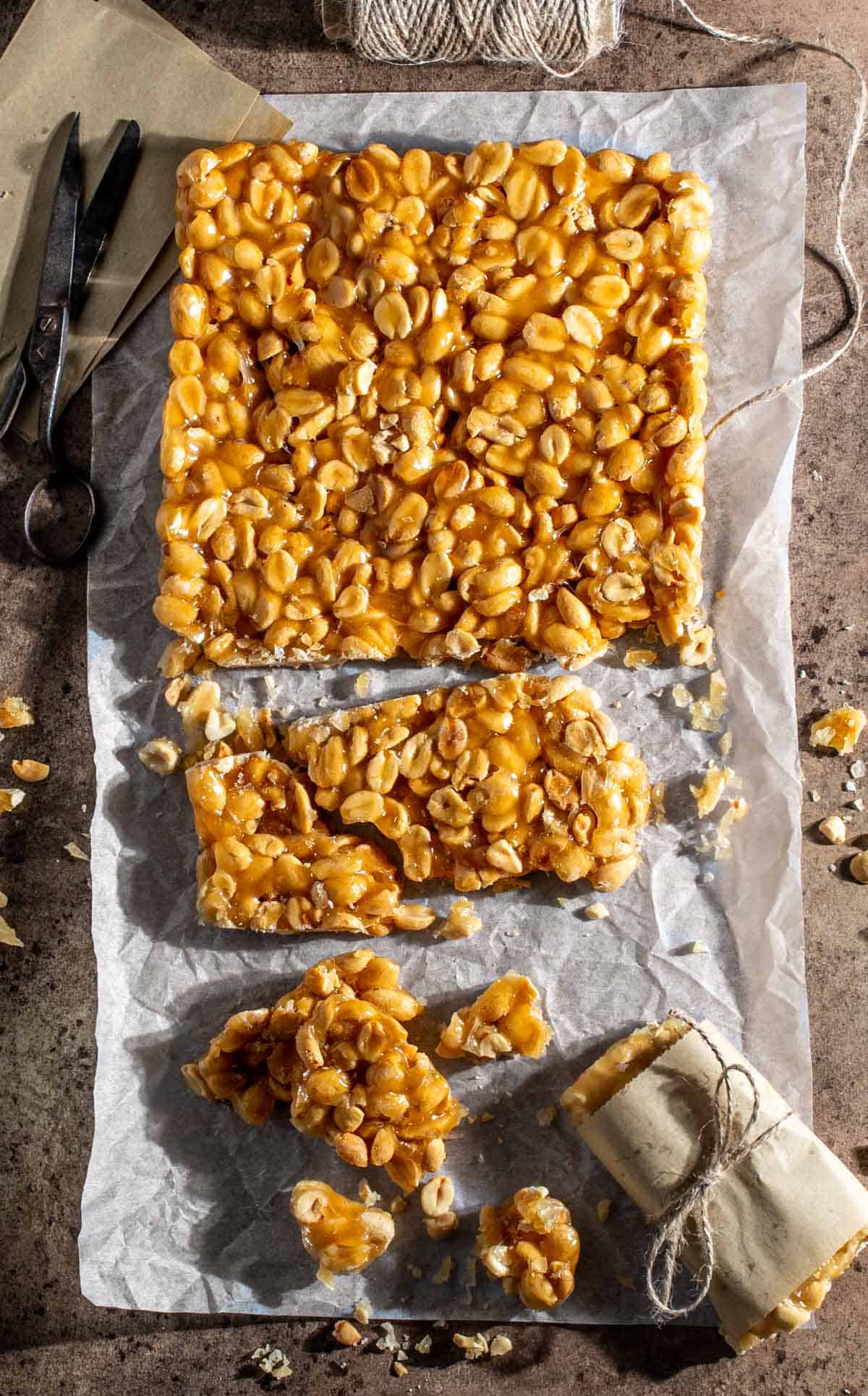
Jump to:
- What is Pé de Moleque?
- Fast facts - Brazil
- What does Pé de Moleque mean?
- What's to love about this recipe
- Key ingredient notes and substitutions
- How to roast peanuts (shelled peanuts):
- A note about the dish to use
- How to make Pé de Moleque: Step-by-step
- Some variations you can experiment with:
- Storage
- More recipes using peanuts
- Recipe
Fast facts - Brazil

| Location | Brazil is located in South America and is the largest country on the continent, sharing borders with every country in South America except for Chile and Ecuador. |
| Language | The official language of Brazil is Portuguese, which is spoken by the vast majority of the population. However, there are also many other languages spoken in Brazil, including Spanish, English, German, Italian and a variety of indigenous languages. |
| Population | Circa 213 million people. |
| Trivia | Brazil is home to the Amazon rainforest, which is the largest and most diverse rainforest in the world, covering over 2.7 million square miles. It is estimated that the Amazon rainforest is home to over 10% of the world's known species of plants and animals, including more than 2,000 species of birds and mammals and over 300 species of reptiles. |
What does Pé de Moleque mean?
There are two possible explanations for the origin of the name "pé de moleque":
Firstly, it could be related to the uneven paving stones found in historic Brazilian cities like Paraty and Ouro Preto that have a similar appearance to the peanut brittle.
Secondly, it could be connected to the street vendors of the past who sold the candy and were often robbed by children. To avoid theft, the vendors would tell the kids to simply ask for it, saying "Pede, moleque!" which means "Ask for it, kid!" in Portuguese.
So the legend goes, "Pe-de" moleque led to pé de moleque. But, pé de moleque directly translates into 'Brat's foot'. So who knows? If you're Brazilian and know the real story, please let us know in the comments!
What's to love about this recipe
- Accessible - By not using light corn syrup, this recipe can be made with ingredients that are easily available anywhere in the world.
- Easy-to-follow instructions - Our recipe comes with step-by-step instructions and visual clues, making it easy even for beginners to make.
- Versatile - There are countless versions of peanut brittle recipes across Brazil and our recipe offers a great starting point for anyone looking to experiment and put their own spin on this classic Brazilian treat.
- Quick - We use ready-salted and roasted peanuts, cutting out the entire process of having to roast it yourself. The whole recipe including resting time can be done in 30 minutes.
Key ingredient notes and substitutions
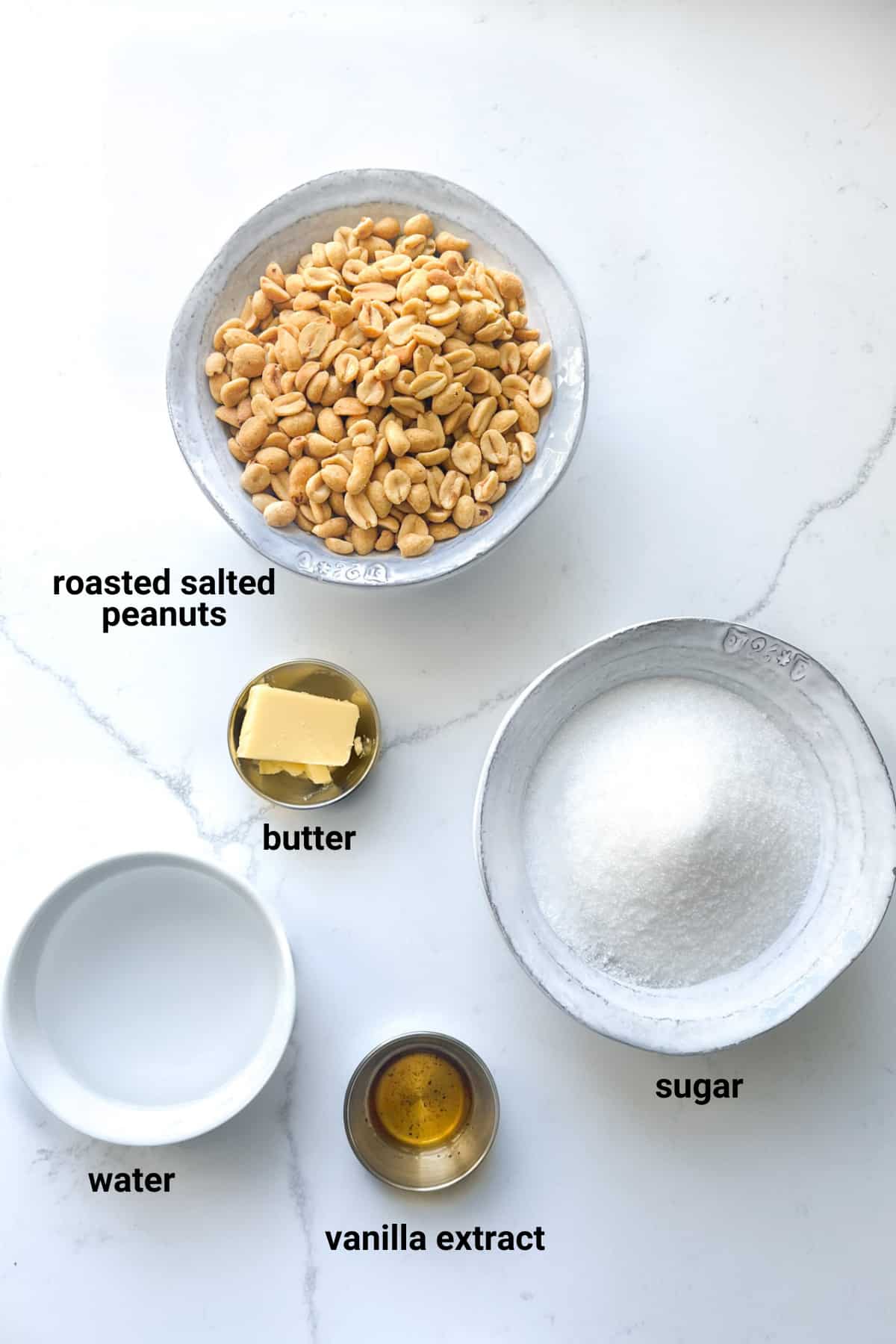
Granulated sugar
Just plain white sugar is needed.
Butter
We use unsalted butter because the peanuts are already salted. If you don't mind an extra salty kick, you can use salted butter.
Vanilla extract
Adds a lovely flavour to the peanut brittle. You can increase this to two teaspoons if you wish, it won't affect the consistency.
Peanuts
This recipe uses ready-salted and roasted peanuts for convenience. If you have raw peanuts you can roast your own very easily.
How to roast peanuts (shelled peanuts):
- Preheat your oven to 180°C (350°F).
- Spread the peanuts in a single layer on a baking sheet.
- Place the baking sheet in the preheated oven and roast the peanuts for 10 to 15 minutes. Keep an eye on them and stir them every 5 minutes to ensure even roasting.
- Remove the baking sheet from the oven and allow the peanuts to cool for a few minutes.
- Taste a peanut to see if it's roasted to your liking. If not, put them back in the oven for a few more minutes and check again.
- Once the peanuts are roasted to your liking, remove them from the oven and let them cool completely.
A note about the dish to use
Use a maximum size dish of 28cm x 18cm (11" x 7"). Anything larger and you may not be able to cover the whole surface with a reasonable thickness of brittle. This size dish will give a brittle thickness of about 1cm. A smaller dish will give thicker brittle.
This is down to preference, as long as you're aware a dish larger than the measurements above may not work well.
How to make Pé de Moleque: Step-by-step
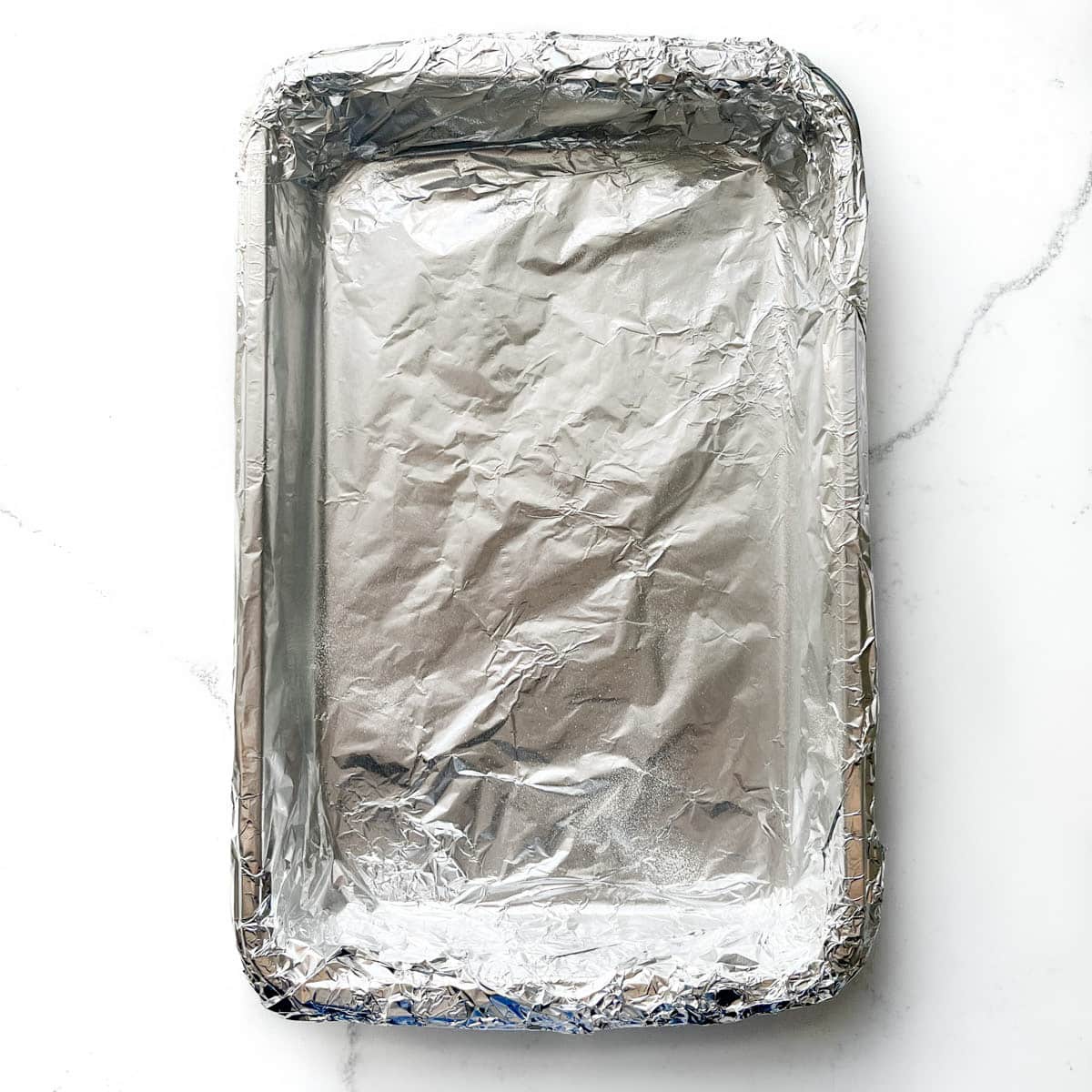
- Cover a baking dish/baking tin completely with foil.
- Apply a thin layer of oil to the foil using either cooking spray or by rubbing a small amount of oil across the surface and sides with a piece of kitchen paper.
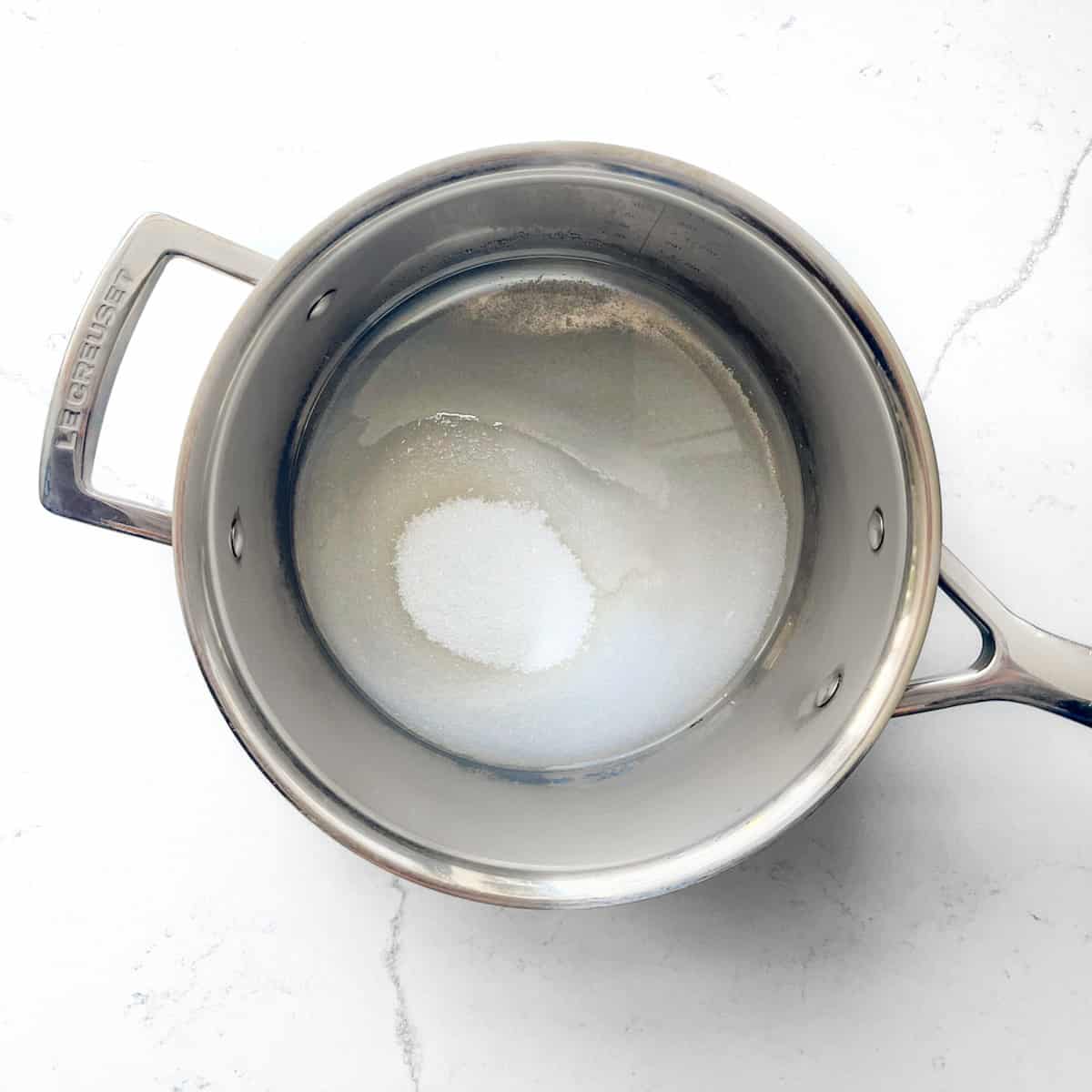
- Place the sugar and water in a large saucepan and stir over medium-low heat until the sugar has completely dissolved. If the mixture begins to boil too rapidly, reduce the heat to low.
Tip: To see if the sugar has melted, dip the back of a spoon in the liquid and check if you can still see sugar grains. If there are no grains, the sugar has melted.
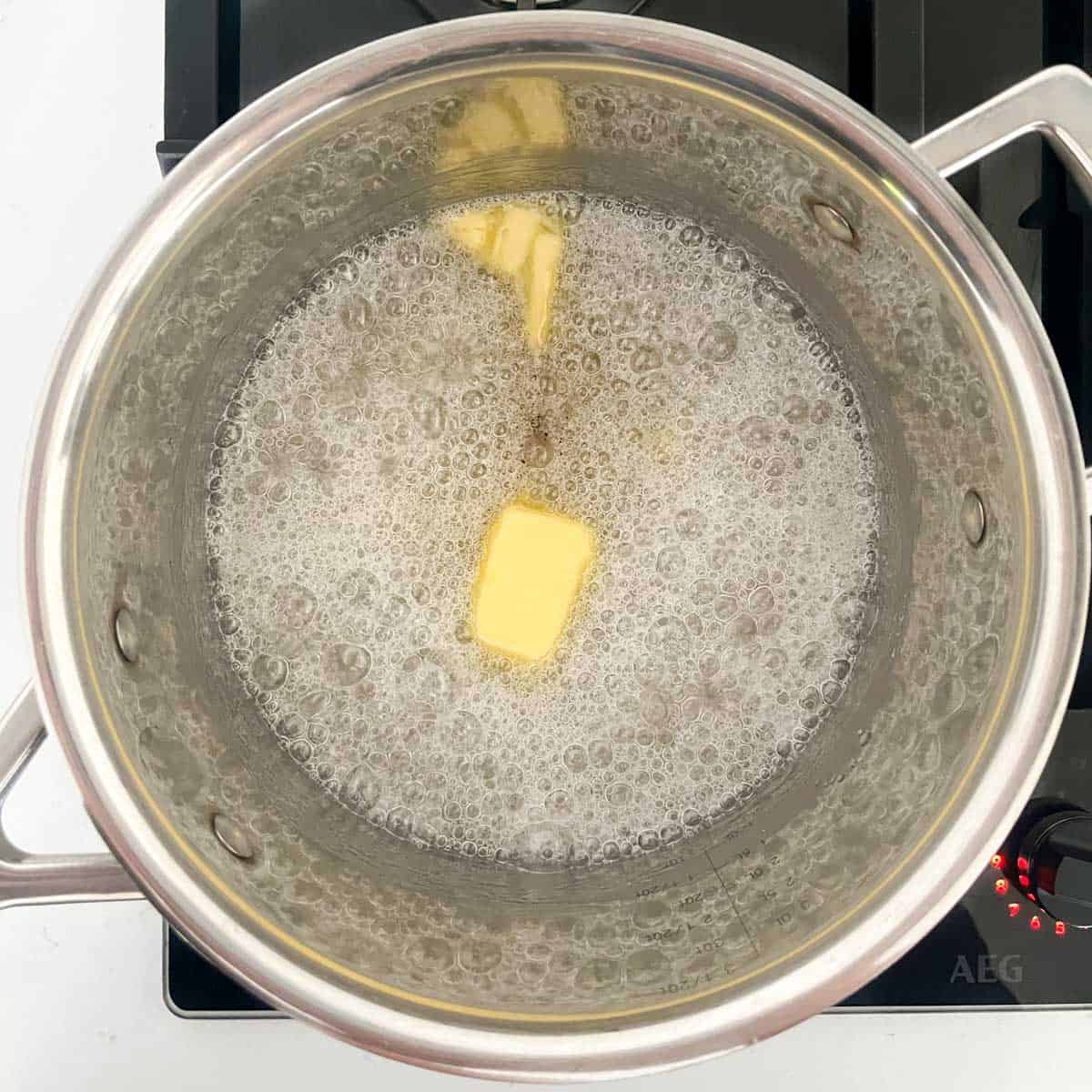
- Once the sugar has dissolved, add the butter and the vanilla extract.
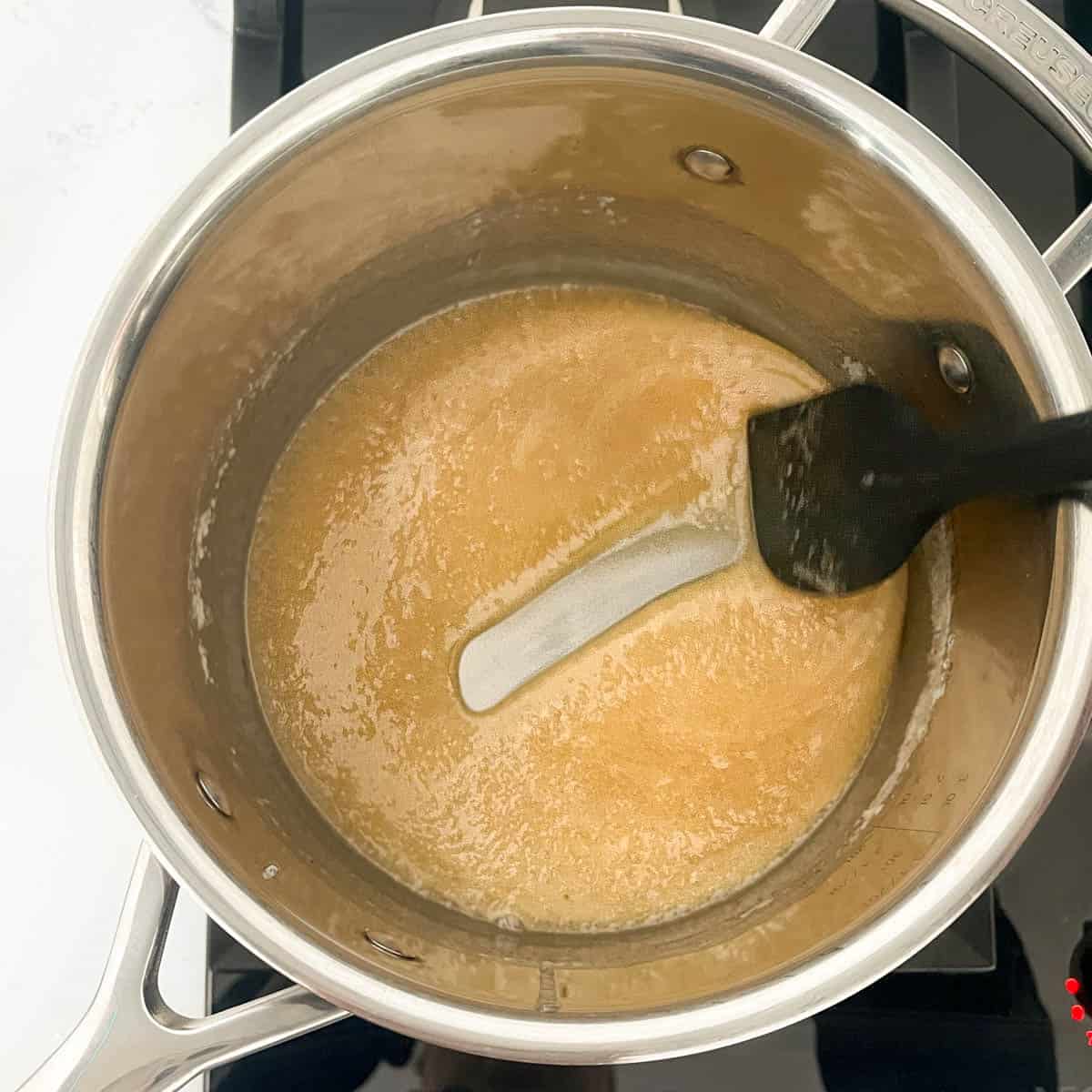
- Continuously stir the mixture over medium-low heat until it thickens and turns into a light caramel colour. The timing for this step will vary depending on the size of your saucepan, but it typically takes about 10-15 minutes.
If you have one and want a precise result, you can use a candy thermometer to measure the temperature of the mixture. It should read between 150-160℃ (300-310℉) to reach the hard-crack stage for the caramel.
Tip: If you don't have a candy thermometer, don't worry. Just check the colour of the mixture. Take the pan off the heat for a moment to let any bubbles disappear so you can see the real colour. Look for a light caramel colour. See photo above.
You can also check the consistency of the caramel: Run a spatula or wooden spoon through it. If it leaves a clear, thick line on the base of the pan that takes a few moments to dissipate, it's ready. See the photo above.
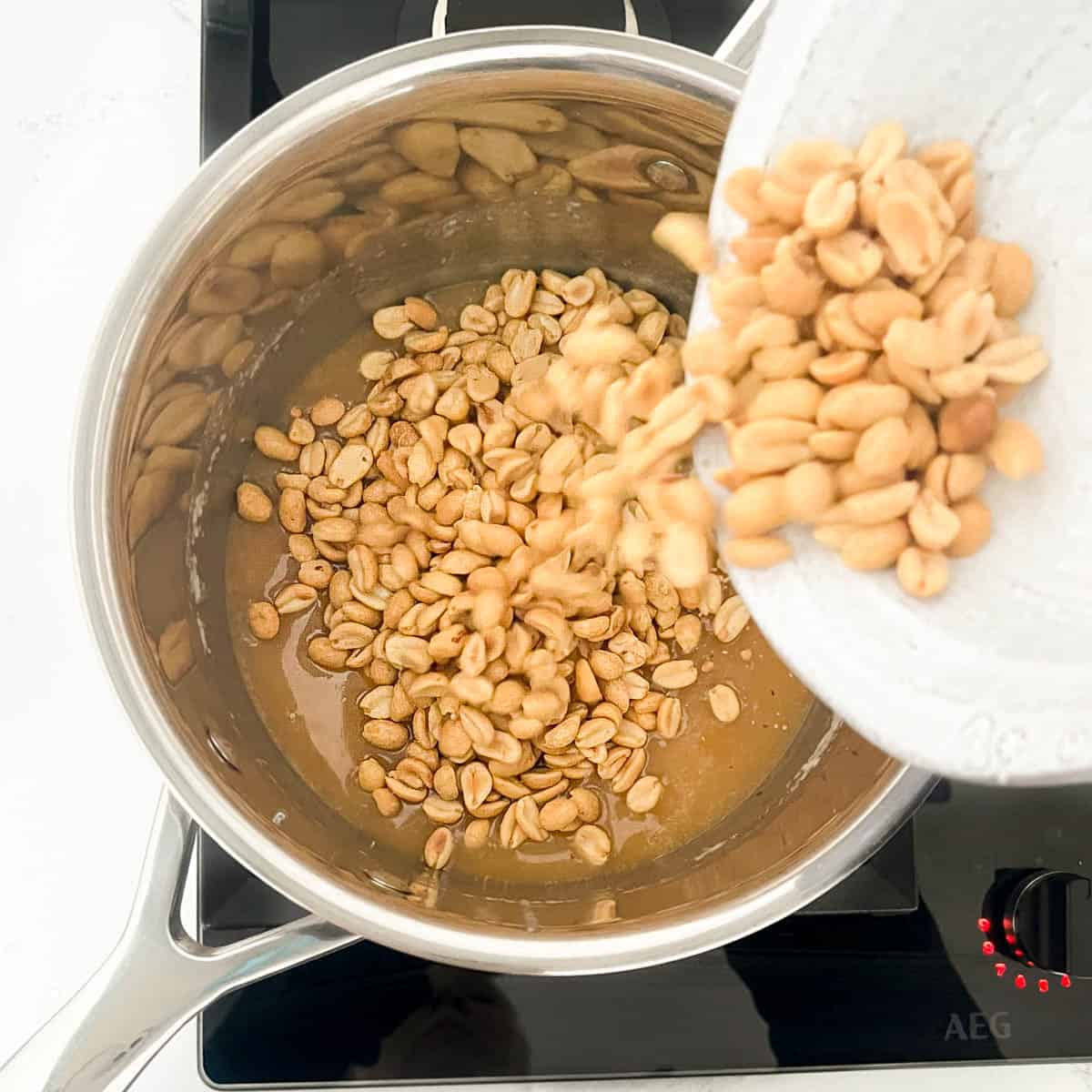
- Once the caramel is ready, take the pan off the heat and add the peanuts. Very quickly stir the peanuts through the caramel and transfer the mixture into the prepared foil-lined dish.
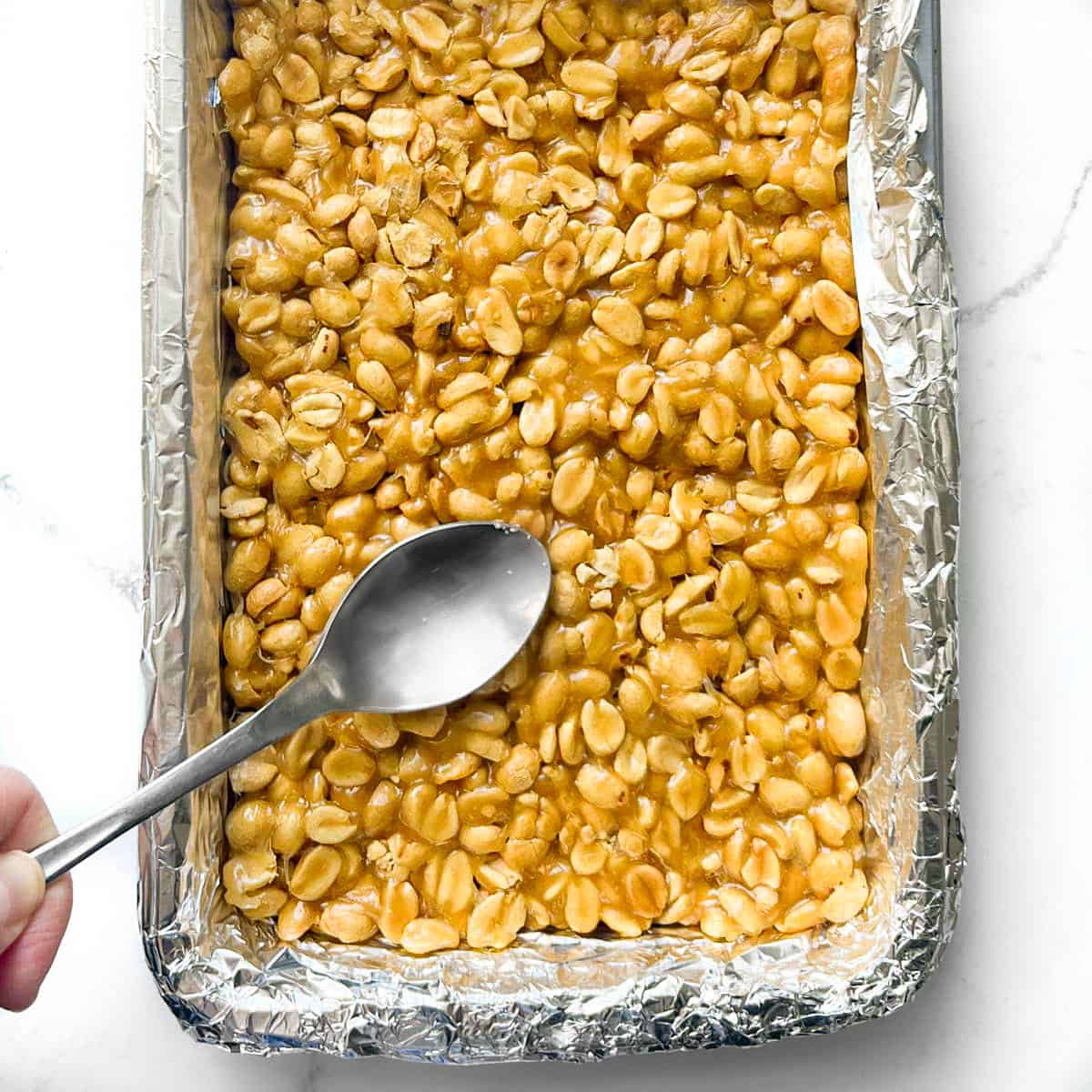
- Use the back of a metal spoon to smooth it out.
Important: You have to work really quickly with this step, ignore everything and just stir, pour and smooth, otherwise the brittle will harden before you can smooth it out in the pan.
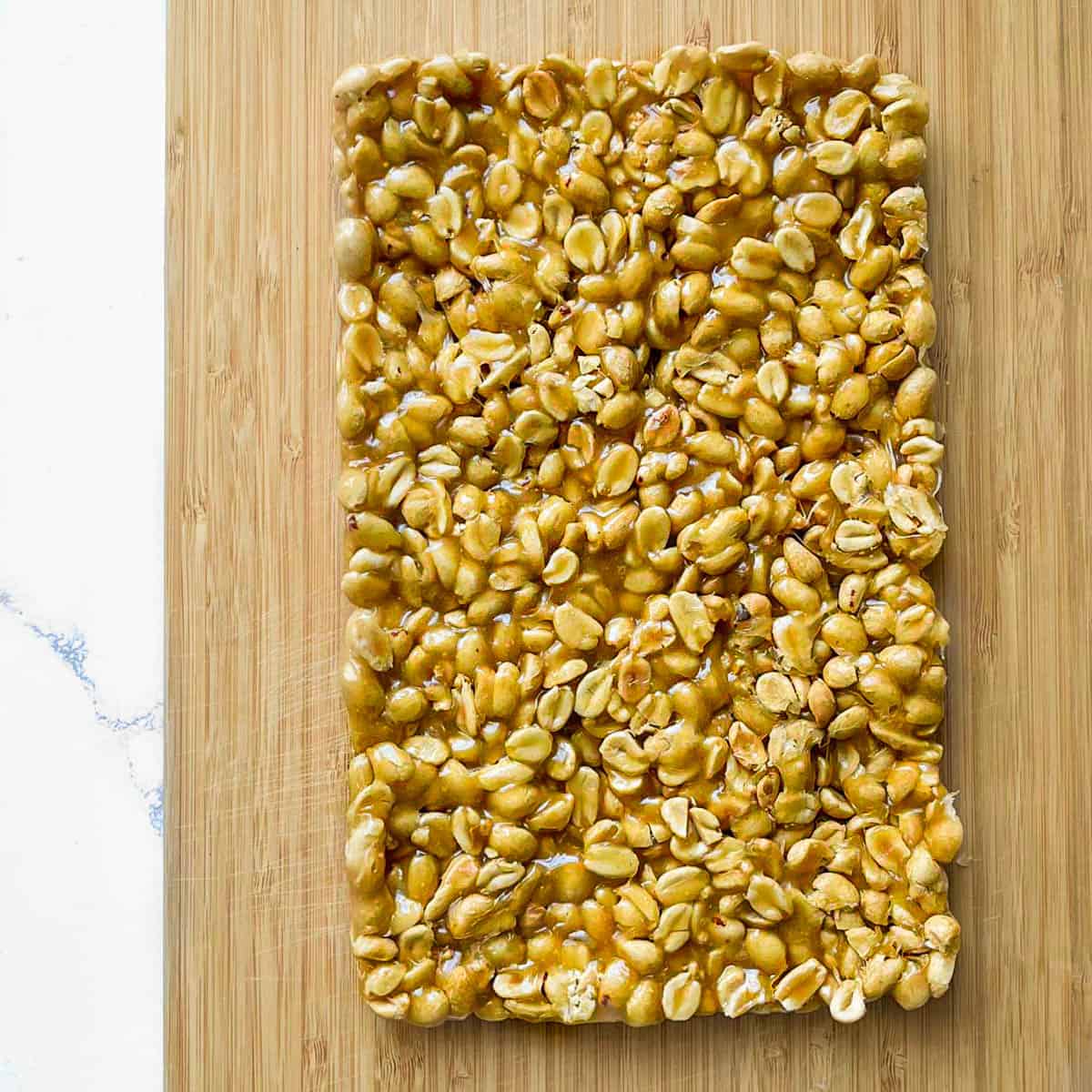
- Leave the peanut brittle to cool for at least 15 minutes. Remove the slab of brittle from the dish and onto a chopping board. Slice or break into pieces.
Full disclosure: Depending on the exact consistency of the brittle, you may find it hard to cut neat slices, it might break. If this happens, abandon perfect slices and just go for the rustic look!
Some variations you can experiment with:
- Chocolate Pé de Moleque - Add cocoa powder to the sugar syrup mixture. This gives the brittle a chocolate flavour and a darker colour.
- Coconut Pé de Moleque - Add shredded coconut to the sugar syrup mixture. The coconut adds a nutty and tropical flavour.
- Cashew Pé de Moleque - Instead of using peanuts, you can use cashews to make "Pe de moleque de caju". This variation is very popular in the Northeast of Brazil, where cashews are abundant.
- Nutella Pé de Moleque - Add Nutella to the sugar syrup mixture. The Nutella gives the brittle a creamy and chocolaty flavour.
- Cinnamon Pé de Moleque - Add cinnamon to the sugar syrup mixture. The cinnamon adds warmth and spice.
Storage
- Let it cool completely before storing it.
- Wrap it tightly in plastic wrap or store it in an airtight container.
- Store it in a cool, dry place away from direct sunlight and heat.
When stored properly, Brazilian peanut brittle can last for several weeks or up to a month. It may become hard over time, but you can soften it by heating it in the microwave or oven.
We would not recommend freezing as it may become sticky.
Here's another interesting titbit about Pé de Moleque from www.kiddle.co
The city of Piranguinho, in the south of the state of Minas Gerais, is known for the artisanal production of sweets, and has stood out on the national scene through the party of the biggest pé-de-moleque in the world, which is part of the municipality's cultural calendar of festivities.
www.kiddle.co
More recipes using peanuts
Recipe
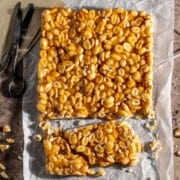
Pé de Moleque - Brazilian Peanut Brittle
Equipment
- 1 baking tin or baking dish of maximum 28cm x 18cm (11" x 7")
- 1 large saucepan
Ingredients
- 300 grams granulated sugar
- 120 millilitre water
- 15 grams butter
- 1 teaspoon vanilla extract
- 300 grams roasted salted peanuts
Instructions
- Cover a baking dish/baking tin completely with foil. Apply a thin layer of oil to the foil using either cooking spray or by rubbing a small amount of oil across the surface and sides with a piece of kitchen paper.About the dish: Use a maximum size of 28cm x 18cm (11" x 7"). Anything larger and you may not be able to cover the whole surface with a reasonable thickness of brittle.
- Place the sugar and water in a large saucepan and stir over medium-low heat until the sugar has completely dissolved. If the mixture begins to boil too rapidly, reduce the heat to low.Tip: To see if the sugar has melted, dip the back of a spoon in the liquid and check if you can still see sugar grains. If there are no grains, the sugar has melted.300 grams granulated sugar, 120 millilitre water
- Once the sugar has dissolved, add the butter and the vanilla extract.15 grams butter, 1 teaspoon vanilla extract
- Continuously stir the mixture over medium-low heat until it thickens and turns into a light caramel colour. The timing for this step will vary depending on the size of your saucepan, but it typically takes about 10-15 minutes.To achieve a precise result, you can use a candy thermometer to measure the temperature of the mixture. It should read between 150-160℃ (300-310℉) to reach the hard-crack stage for the caramel.Tip: If you don't have a candy thermometer, don't worry. Just check the colour of the mixture. Take the pan off the heat for a moment to let any bubbles disappear so you can see the real colour. Look for a light caramel colour.You can also check the consistency of the caramel. Run a spatula through it. If it leaves a clear, thick line on the base of the pan that takes a few moments to dissipate, it's ready. See photo above.
- Once the caramel is ready, take the pan off the heat and add the peanuts. Very quickly stir the peanuts through the caramel and transfer the mixture into the prepared foil-lined dish. Use the back of a metal spoon to smooth it out.Important: You have to work really quickly with this step, ignore everything and just stir, pour and smooth, otherwise the brittle will harden before you can smooth it out in the pan.300 grams roasted salted peanuts
- Leave the Pé de Moleque to cool for at least 15 minutes. Remove the slab of brittle from the dish and onto a chopping board. Slice or break into pieces. Full disclosure: Depending on the exact consistency of the brittle, you may find it's hard to cut neat slices, it might break. If this happens, abandon perfect slices and just go for the rustic look.
**Nutritional data disclaimer**
Please keep in mind that the nutritional information provided below is calculated by a third party and we cannot guarantee the accuracy. We try our best to give you the most accurate information, but we do not take responsibility for errors that may be present. Also, the nutritional value of the recipe may change depending on the exact brands and products used. We recommend that you consult with a qualified healthcare professional or registered dietitian for personalised advice on your dietary needs.
Nutrition
For food safety advice, including guidance on food allergies




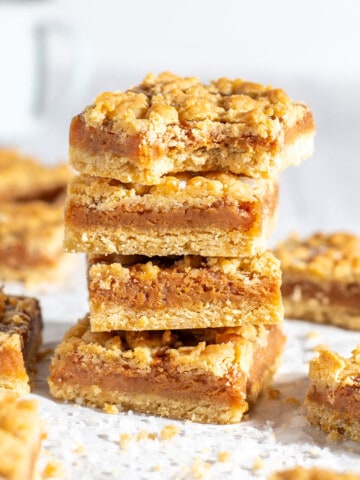
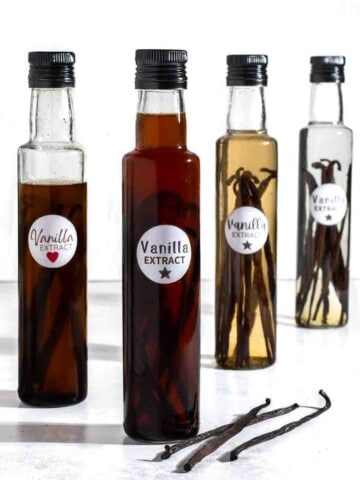
Leave a Reply